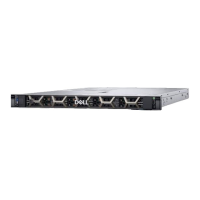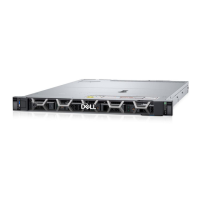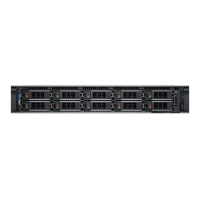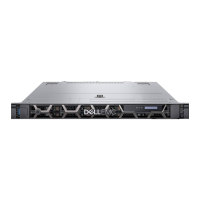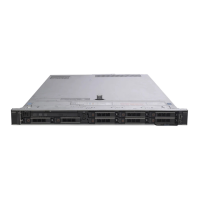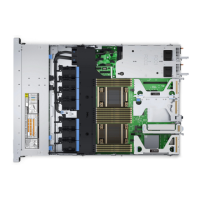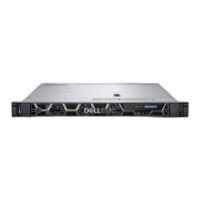Do you have a question about the Dell PowerEdge R6615 and is the answer not in the manual?
Details the components and features visible on the front of the Dell PowerEdge R6615 server.
Describes the components and ports located on the rear panel of the Dell PowerEdge R6615 server.
Provides an internal view of the Dell PowerEdge R6615 server, identifying key components.
Explains how to find the unique Express Service Code and Service Tag for system identification.
Details the location and information found on the system information label.
Information on rail solutions compatible with the system and rack mounting.
Provides the physical dimensions of the Dell PowerEdge R6615 server chassis.
Details the weight specifications for the Dell PowerEdge R6615 system.
Outlines the specifications for the processors supported by the Dell PowerEdge R6615.
Details the specifications for the Power Supply Units (PSUs) supported by the system.
Lists the operating systems that are officially supported by the Dell PowerEdge R6615.
Provides specifications for the cooling fans used in the Dell PowerEdge R6615 system.
Details the type and specifications of the system battery used in the server.
Information on the expansion card riser configurations and supported PCIe slots.
Details the memory specifications, including type, rank, capacity, and speed.
Lists the supported storage controller cards for the Dell PowerEdge R6615.
Information on the types and configurations of drives supported by the system.
Details the specifications for various ports and connectors on the system.
Outlines the supported video resolution options for the integrated graphics controller.
Specifies the environmental operating conditions and limitations for the system.
Details thermal restrictions for air cooling based on component configuration and TDP.
General steps for unpacking, installing, connecting, and powering on the server.
Information on configuring the Integrated Dell Remote Access Controller (iDRAC).
Lists resources and documentation for installing a supported operating system.
Guidance on downloading system drivers and firmware from the Dell FTP site.
Describes methods for downloading and installing operating system drivers.
Steps to download and install the latest BIOS, drivers, and system management firmware.
Accessing and configuring BIOS, iDRAC, and device settings through the system setup utility.
Details the options available within the System BIOS for system configuration.
View system model, BIOS version, Service Tag, and manufacturer details.
Configure system memory size, type, speed, testing, and refresh delay.
Configure processor-related settings such as logical processors and virtualization.
Configure embedded SATA options, including RAID modes and security freeze lock.
Configure NVMe drive mode and BIOS NVMe driver settings.
Set the system boot mode to BIOS or UEFI and specify the boot order.
Configure UEFI PXE, HTTP, ISCSI, and NVMe-oF network boot settings.
Enable or disable integrated system devices like USB ports, RAID controllers, and NICs.
Configure serial communication ports, addresses, and redirection settings.
Configure system performance profiles, CPU power management, and memory frequency.
Configure system security features like passwords, TPM, and Secure Boot.
Lists the minimum hardware components required for the system to POST.
Describes how the system validates installed components against qualified configurations.
Details error messages displayed during POST or captured in system event logs.
Essential safety guidelines and precautions to follow before servicing the system.
Prerequisites and steps to prepare the system before internal component access.
Steps to reassemble and finalize after internal component servicing.
List of tools required for component removal and installation procedures.
Instructions for removing and installing the optional front bezel.
Procedures for removing and installing the system cover.
Steps for removing and installing the drive backplane cover.
Instructions for removing and installing the air shroud for proper cooling.
Procedures for removing and installing cooling fans.
Guidance on removing and installing drive blanks and carriers.
Detailed steps for removing a drive carrier from the system.
Detailed steps for installing a drive carrier into the system.
Instructions for removing a drive from its carrier.
Instructions for installing a drive into its carrier.
Procedures for removing and installing the rear drive module.
Details supported drive backplane options and cable connections.
Steps for safely removing the drive backplane.
Steps for correctly installing the drive backplane.
Information on side and center bracket perfect sealing for different configurations.
Instructions for removing the side wall brackets.
Instructions for installing the side wall brackets.
Diagrams illustrating cable routing for various configurations.
Procedures for removing and installing front and rear mounting PERC modules.
Guidelines for installing and removing system memory modules (DIMMs).
Step-by-step instructions for removing a memory module.
Step-by-step instructions for installing a memory module.
Procedures for removing and installing processors and heat sinks.
Instructions for removing the heat sink assembly.
Steps to remove the Direct Liquid Cooling (DLC) module.
Instructions for removing the AMD processor.
Instructions for installing the AMD processor.
Steps for installing the heat sink assembly.
Steps for installing the Direct Liquid Cooling (DLC) module.
Guidelines for installing expansion cards into expansion card risers.
Steps to remove an expansion card from its riser.
Steps to install an expansion card into its riser.
Procedures for removing and installing the optional serial COM port.
Procedures for removing and installing the VGA module.
Procedures for removing and installing M.2 NVMe SSD modules.
Procedures for removing and installing BOSS-N1 module blanks and modules.
Instructions for replacing the system battery.
Procedures for removing and installing the internal USB card.
Procedures for removing and installing the intrusion switch module.
Procedures for removing and installing the Optional OCP card.
Procedures for removing and installing the right and left control panels.
Information on PSU hot spare feature and procedures for PSU blank replacement.
Steps to remove the PSU blank.
Steps to install the PSU blank.
Steps to remove a power supply unit (PSU).
Steps to install a power supply unit (PSU).
Information on upgrading the Trusted Platform Module (TPM).
Procedures for removing and installing the system board.
Procedures for removing and installing the LOM card and rear I/O board.
Details the BOSS-N1 module kit components and prerequisites for installation.
Information about the DPU kit, including its components and installation.
Identifies and describes connectors on the system board.
Details jumper settings on the system board for BIOS configuration.
Procedure to disable system passwords using the password jumper.
Describes the status and conditions of the power button LED.
Explains the meaning of status LED indicators and corrective actions.
Details system health and ID indicator codes and their meanings.
Describes the indicator codes for the iDRAC Quick Sync 2 module.
Explains the indicator codes for the iDRAC Direct port.
Information on the LCD panel features, status, and conditions.
Describes the indicator codes for Network Interface Controllers (NICs).
Explains the status indicator codes for AC and DC power supply units (PSUs).
Describes the drive indicator codes and their meanings.
Guidance on running system diagnostics for troubleshooting.
Information on product disposal and recycling services.
Provides information on how to contact Dell for support and services.
Guide on using Quick Resource Locator (QRL) for system information.
Details the components and features visible on the front of the Dell PowerEdge R6615 server.
Describes the components and ports located on the rear panel of the Dell PowerEdge R6615 server.
Provides an internal view of the Dell PowerEdge R6615 server, identifying key components.
Explains how to find the unique Express Service Code and Service Tag for system identification.
Details the location and information found on the system information label.
Information on rail solutions compatible with the system and rack mounting.
Provides the physical dimensions of the Dell PowerEdge R6615 server chassis.
Details the weight specifications for the Dell PowerEdge R6615 system.
Outlines the specifications for the processors supported by the Dell PowerEdge R6615.
Details the specifications for the Power Supply Units (PSUs) supported by the system.
Lists the operating systems that are officially supported by the Dell PowerEdge R6615.
Provides specifications for the cooling fans used in the Dell PowerEdge R6615 system.
Details the type and specifications of the system battery used in the server.
Information on the expansion card riser configurations and supported PCIe slots.
Details the memory specifications, including type, rank, capacity, and speed.
Lists the supported storage controller cards for the Dell PowerEdge R6615.
Information on the types and configurations of drives supported by the system.
Details the specifications for various ports and connectors on the system.
Outlines the supported video resolution options for the integrated graphics controller.
Specifies the environmental operating conditions and limitations for the system.
Details thermal restrictions for air cooling based on component configuration and TDP.
General steps for unpacking, installing, connecting, and powering on the server.
Information on configuring the Integrated Dell Remote Access Controller (iDRAC).
Lists resources and documentation for installing a supported operating system.
Guidance on downloading system drivers and firmware from the Dell FTP site.
Describes methods for downloading and installing operating system drivers.
Steps to download and install the latest BIOS, drivers, and system management firmware.
Accessing and configuring BIOS, iDRAC, and device settings through the system setup utility.
Details the options available within the System BIOS for system configuration.
View system model, BIOS version, Service Tag, and manufacturer details.
Configure system memory size, type, speed, testing, and refresh delay.
Configure processor-related settings such as logical processors and virtualization.
Configure embedded SATA options, including RAID modes and security freeze lock.
Configure NVMe drive mode and BIOS NVMe driver settings.
Set the system boot mode to BIOS or UEFI and specify the boot order.
Configure UEFI PXE, HTTP, ISCSI, and NVMe-oF network boot settings.
Enable or disable integrated system devices like USB ports, RAID controllers, and NICs.
Configure serial communication ports, addresses, and redirection settings.
Configure system performance profiles, CPU power management, and memory frequency.
Configure system security features like passwords, TPM, and Secure Boot.
Lists the minimum hardware components required for the system to POST.
Describes how the system validates installed components against qualified configurations.
Details error messages displayed during POST or captured in system event logs.
Essential safety guidelines and precautions to follow before servicing the system.
Prerequisites and steps to prepare the system before internal component access.
Steps to reassemble and finalize after internal component servicing.
List of tools required for component removal and installation procedures.
Instructions for removing and installing the optional front bezel.
Procedures for removing and installing the system cover.
Steps for removing and installing the drive backplane cover.
Instructions for removing and installing the air shroud for proper cooling.
Procedures for removing and installing cooling fans.
Guidance on removing and installing drive blanks and carriers.
Detailed steps for removing a drive carrier from the system.
Detailed steps for installing a drive carrier into the system.
Instructions for removing a drive from its carrier.
Instructions for installing a drive into its carrier.
Procedures for removing and installing the rear drive module.
Details supported drive backplane options and cable connections.
Steps for safely removing the drive backplane.
Steps for correctly installing the drive backplane.
Information on side and center bracket perfect sealing for different configurations.
Instructions for removing the side wall brackets.
Instructions for installing the side wall brackets.
Diagrams illustrating cable routing for various configurations.
Procedures for removing and installing front and rear mounting PERC modules.
Guidelines for installing and removing system memory modules (DIMMs).
Step-by-step instructions for removing a memory module.
Step-by-step instructions for installing a memory module.
Procedures for removing and installing processors and heat sinks.
Instructions for removing the heat sink assembly.
Steps to remove the Direct Liquid Cooling (DLC) module.
Instructions for removing the AMD processor.
Instructions for installing the AMD processor.
Steps for installing the heat sink assembly.
Steps for installing the Direct Liquid Cooling (DLC) module.
Guidelines for installing expansion cards into expansion card risers.
Steps to remove an expansion card from its riser.
Steps to install an expansion card into its riser.
Procedures for removing and installing the optional serial COM port.
Procedures for removing and installing the VGA module.
Procedures for removing and installing M.2 NVMe SSD modules.
Procedures for removing and installing BOSS-N1 module blanks and modules.
Instructions for replacing the system battery.
Procedures for removing and installing the internal USB card.
Procedures for removing and installing the intrusion switch module.
Procedures for removing and installing the Optional OCP card.
Procedures for removing and installing the right and left control panels.
Information on PSU hot spare feature and procedures for PSU blank replacement.
Steps to remove the PSU blank.
Steps to install the PSU blank.
Steps to remove a power supply unit (PSU).
Steps to install a power supply unit (PSU).
Information on upgrading the Trusted Platform Module (TPM).
Procedures for removing and installing the system board.
Procedures for removing and installing the LOM card and rear I/O board.
Details the BOSS-N1 module kit components and prerequisites for installation.
Information about the DPU kit, including its components and installation.
Identifies and describes connectors on the system board.
Details jumper settings on the system board for BIOS configuration.
Procedure to disable system passwords using the password jumper.
Describes the status and conditions of the power button LED.
Explains the meaning of status LED indicators and corrective actions.
Details system health and ID indicator codes and their meanings.
Describes the indicator codes for the iDRAC Quick Sync 2 module.
Explains the indicator codes for the iDRAC Direct port.
Information on the LCD panel features, status, and conditions.
Describes the indicator codes for Network Interface Controllers (NICs).
Explains the status indicator codes for AC and DC power supply units (PSUs).
Describes the drive indicator codes and their meanings.
Guidance on running system diagnostics for troubleshooting.
Information on product disposal and recycling services.
Provides information on how to contact Dell for support and services.
Guide on using Quick Resource Locator (QRL) for system information.
| Memory slots | 12x DIMM |
|---|---|
| Memory ranking | 1 |
| Internal memory | 16 GB |
| Buffered memory type | Registered (buffered) |
| Internal memory type | DDR5-SDRAM |
| Maximum internal memory | 768 GB |
| Memory layout (slots x size) | 1 x 16 GB |
| USB 2.0 ports quantity | USB 2.0 ports have a data transmission speed of 480 Mbps, and are backwards compatible with USB 1.1 ports. You can connect all kinds of peripheral devices to them. |
| Ethernet LAN (RJ-45) ports | 2 |
| Ethernet LAN | Yes |
| Cabling technology | 10/100/1000Base-T(X) |
| Ethernet interface type | Gigabit Ethernet |
| Operating system installed | No |
| Compatible operating systems | Canonical Ubuntu Server LTS Microsoft Windows Server with Hyper-V Red Hat Enterprise Linux SUSE Linux Enterprise Server VMware ESXi |
| SSD size | 2.5\ |
| SSD capacity | The Solid State Drive's storage capacity in Gigabytes. |
| SSD interface | SATA III |
| Supported SSD sizes | 3.5\ |
| Total storage capacity | 480 GB |
| Maximum storage capacity | - TB |
| Number of SSDs supported | 4 |
| Storage drive adapter type | 2.5\ |
| Supported RAID controllers | PERC H355 |
| Chassis type | Rack (1U) |
| Product color | Black |
| Processor cache | 64 MB |
| Processor cores | 16 |
| Processor model | 9124 |
| Processor family | AMD EPYC |
| Processor threads | 32 |
| Processor frequency | 3 GHz |
| Processor manufacturer | AMD |
| Processor boost frequency | 3.7 GHz |
| Thermal Design Power (TDP) | 200 W |
| Power supply | 800 W |
| Power cable length | 2 m |
| Power cable current | 12 A |
| Power cable connector 1 | C13 coupler |
| Power cable connector 2 | C14 coupler |
| Data transfer rate | 6 Gbit/s |
| Width | 482 mm |
|---|---|
| Height | 42.8 mm |


